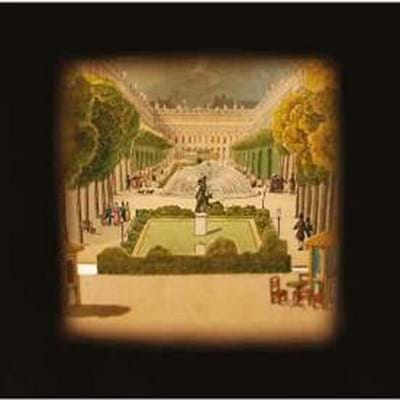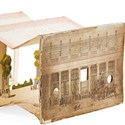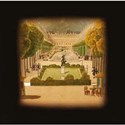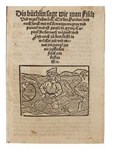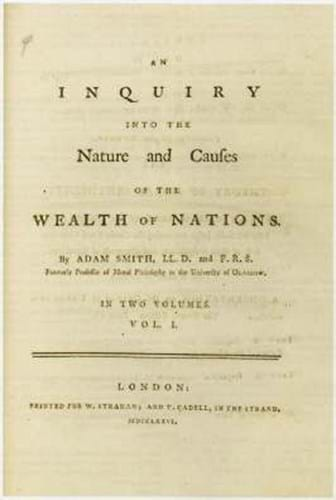
Adam Smith’s Wealth of Nations
A 1776 first edition of Adam Smith’s …Wealth of Nations was discovered by a Hansons (20% buyer’s premium) specialist during the last minutes of cataloguing for an October contents sale at Staffordshire country house Bishton Hall.
The family was aware of its existence somewhere in the home but had been unable to pinpoint its whereabouts. The bindings of full contemporary calf were somewhat worn and scuffed, and in the second volume a few pages had been bound in the wrong order (as acknowledged in a contemporary footnote), but essentially it was a good, clean example of this famous economic text.
The selling price of £65,000 just edges the Bishton Hall copy into the top half-dozen prices achieved at auction.
When first published by London firm Strahan and Cadell in 1776, Smith’s masterpiece cost £1 16 shillings, with the first edition running to around 2000 copies.
Australian engraving
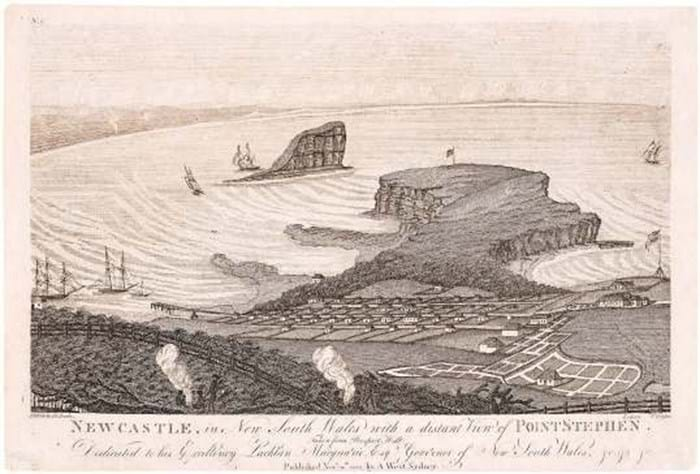
An engraved view of Newcastle in New South Wales published in 1812 that sold for Aus$15,500 (£8855) at Peter Arnold in Melbourne, Victoria.
This engraved view of Newcastle in New South Wales published in 1812 is based on a drawing by Richard Browne, who had arrived as a convict in colonial Australia the previous year. The engraver was fellow prisoner Walter Preston, who on arrival had been assigned to work for the publisher Absalom West.
The series of 24 topographical views published by the firm in 1812-14 were the first to appear in the colony. This view, No 6 in the series, sold for Aus$15,500 (£8855) at a December 5 sale held by Peter Arnold (18% buyer’s premium) in Melbourne, Victoria.
Early railway tickets
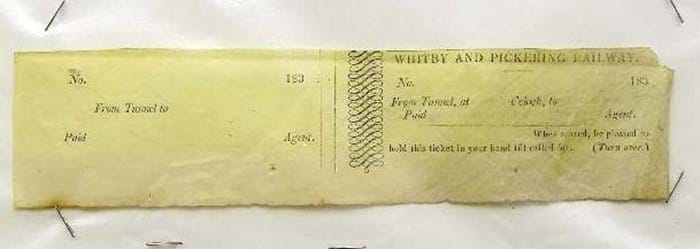
One of a trio of tickets issued by one of the UK’s first passenger railways thatsold for £1050 at David Duggleby.
A trio of tickets issued by one of the UK’s first passenger railways sold for £1050 at David Duggleby (21% buyer’s premium) in Scarborough on February 22.
The Whitby & Pickering Railway (now the ‘heritage’ North Yorkshire Moors Railway) received royal assent in May 1833 and just two years later (June 8, 1835), the line between Whitby and the Tunnel Inn (now Grosmont) was open, with the full route operating from May 26, 1836.
Alongside goods wagons, three coaches were acquired from Beeston & Melling of Manchester allowing for a passenger service that connected at Pickering with the stagecoach to York. These hand-cut paper tickets – a set of three for the journeys from Whitby, Tunnel and Pickering – were one of only 12 surviving sets cut from unused sheets.
Stephen Hawking online auction
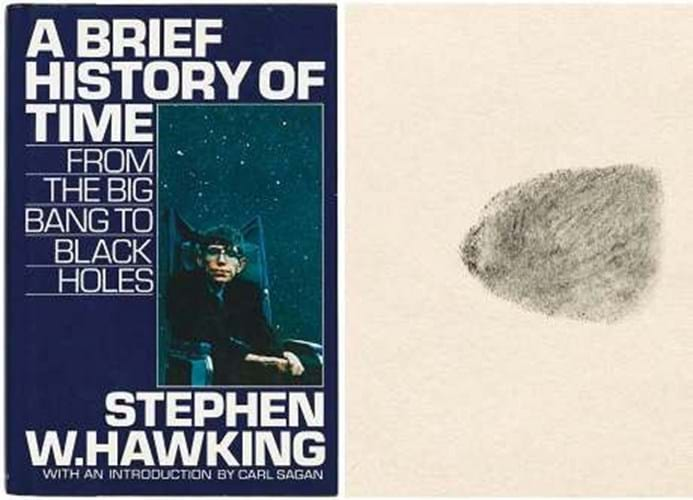
A 1988 first American edition of ‘A Brief History of Time…’ that had been ‘signed’ with an authorial thumbprint by Stephen Hawking – £55,000 at Christie’s.
Personal items from the estate of Stephen Hawking, who died last year, were offered by Christie’s (25/20/12.5% buyer’s premium) at an online auction that ended on November 8.
The star turn was one of the five known copies of his Cambridge PhD thesis of 1965, Properties of Expanding Universes. Showing a number of autograph corrections, it is signed in two places and inscribed This dissertation is my original work. It made £480,000.
Estimated at £2000-3000 but sold for £55,000 was a 1988, first American edition of A Brief History of Time… that had been ‘signed’ with an authorial thumbprint on the front free endpaper.
William III's Triumphant Reception
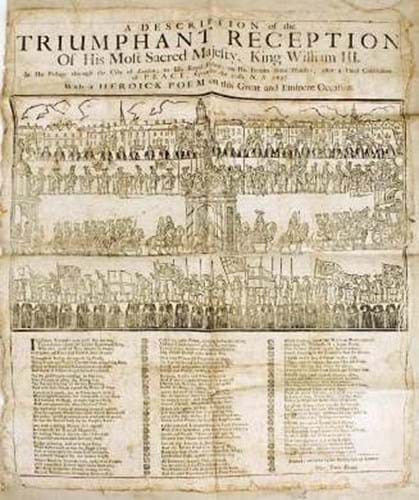
‘The Triumphant Reception of… King William III’ – £3300 at Lockdales.
Sold for £3300 at Lockdales (19.5% buyer’s premium) of Ipswich on February 20 was this broadsheet, now mounted on linen, that celebrates the Triumphant Reception of… King William III following his return to London from Flanders after the conclusion of a peace treaty.
This would have been the 1697 Treaty of Ryswick, in which France, after years of conflict, effectively recognised William as sole ruler of Britain and Ireland – his wife and sovereign partner, Queen Mary, having died three years earlier.
Paris peepshow
Sold for £600 at Lyon & Turnbull (25/20% buyer’s premium) in Edinburgh on October 2 was this concertina-form peepshow produced in Paris c.1820 and featuring Le Palais Royal. Handcoloured sections of the theatre open out behind a cut and colonnaded front that measures 5 x 7½in (13 x 19cm). The peep inside provides a colourful and dramatic effect.
Russian flora lithographs
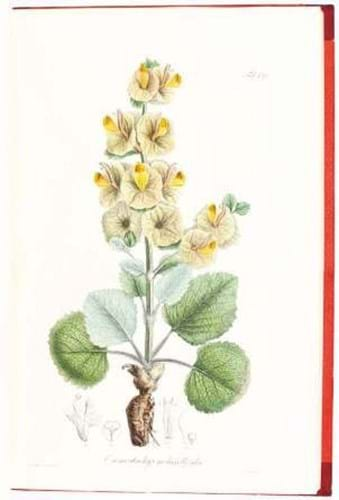
A plate from ‘Icones Plantarum novarum… floram Rossicam’ by Carl Friedrich von Ledebour that sold for €60,000 (£51,960) at Reiss & Sohn (18% buyer’s premium).
Featuring 500 coloured litho plates, Icones Plantarum novarum… floram Rossicam by the German-Estonian botanist Carl Friedrich von Ledebour is recognised as one of the great works on Russian flora.
This exceptional set of the five-volume work of 1829-34 was once part of the private library of Emperor Francis I of Austria and is handsomely bound in contemporary red half calf gilt.
It sold for €60,000 (£51,960) as part of the botanical section of a Reiss & Sohn (18% buyer’s premium) series of auctions held from October 30-November 1.
Quebeck letter

‘A Letter from Quebeck, in Canada’ – $8000 (£6085) at Bonhams New York.
A Letter from Quebeck, in Canada, to M L’Maine, a French Officer is a rare item of political propaganda printed in Boston in 1754. It tells of French forces and their Indian counterparts amassing in numbers and of plans “…which give us a glorious Prospect of adding a Kingdom to our dread Sovereign’s Dominion”.
With its pro-Catholic overtones, the spurious eight-page account was printed to stoke fears in the colonies and shift opinion towards what would become the French & Indian War. It has since been attributed to William Smith, a pamphleteer and provost of the College of Philadelphia.
Offered uncut and unopened and bearing the contemporary ink subscription of one Nathaniel Sparhawk, it sold at $8000 (£6085) at Bonhams New York (25/20/12% buyer’s premium) on September 25.
Boston Massacre in print
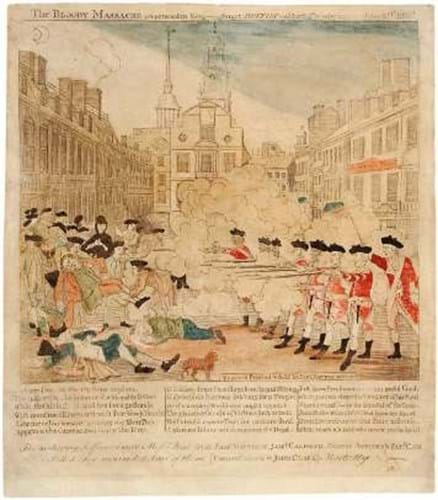
A first edition, second state copy of Paul Revere’s famous depiction of ‘The Bloody Massacre perpetrated in King Street Boston on March 5th 1770’ – $290,000 (£223,075) at Christie’s New York.
At Christie’s New York (25/20/12.5% buyer’s premium) on December 4, a first edition, second state copy of Paul Revere’s famous depiction of The Bloody Massacre perpetrated in King Street Boston on March 5th 1770… sold for $290,000 (£223,075).
Contemporary witnesses, chroniclers and those involved later told very different stories of what actually happened, but Revere’s print and poem, issued within a very few weeks of the “fateful brawl”, quickly achieved iconic status and is one of the more successful examples of political propaganda of all time.
This example has its original colouring.
17th century Tabulae Rudolphinae

Johannes Kepler’s ‘Tabulae Rudolphinae’ – SKr350,000 (£30,535) at Stockholms Auktionsverk.
Johannes Kepler’s Tabulae Rudolphinae… is an important catalogue of stars and planetary tables named in honour of the Holy Roman Emperor, Rudolf II.
Published in Ulm in 1627, it is an accumulation of data initially undertaken by the great Danish astronomer Tycho Brahe that, following his death in 1601, was continued for many years afterwards by Kepler, the German astronomer best known for his laws of planetary motion.
This copy in a defective but contemporary vellum binding, sold for SKr350,000 (£30,535) by Stockholms Auktionsverk (22.5% buyer’s premium) on December 7, also contains a striking, double-headed eagle map by Philip Eckebrecht that is not found in all copies.
It is dated 1630 but was almost certainly issued after 1658, the year the dedicatee, Emperor Leopold, came to the throne.
Fairy hoax
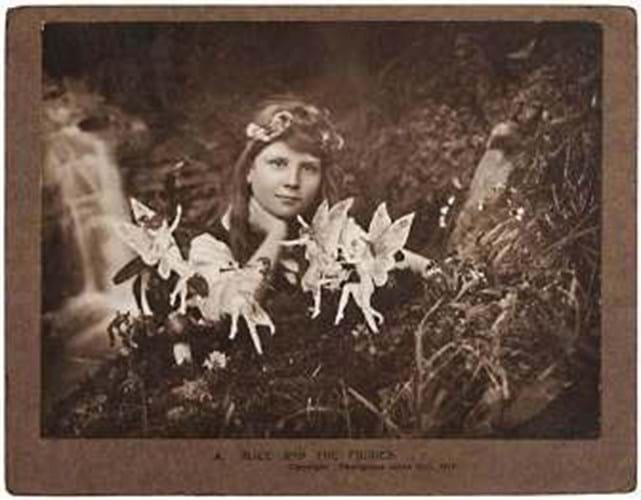
One of two photographs of the so-called ‘Cottingley Fairies’ that sold at Dominic Winter.
Two photographs of the so-called ‘Cottingley Fairies’, the hoax that famously duped Arthur Conan Doyle, went under the hammer at Dominic Winter in Cirencester on October 4.
The sepia gelatin silver prints were taken as a practical joke in the village of Cottingley in West Yorkshire in July 1917 by Elsie Wright (1901-88) and her cousin Frances Griffiths (1907-86), using drawings secured in the ground with hat pins.
Convinced they were authentic, Conan Doyle published five of the 6 x 4½in (15 x 11cm) photographs in 1920.
Both with original mounts and printed captions, and each guided at £700-1000, Alice and the Fairies, the first in the series of five, sold at £15,000 (plus 20% buyer’s premium). Iris and the Gnome, the second, took £5400.
Art Nouveau statement piece
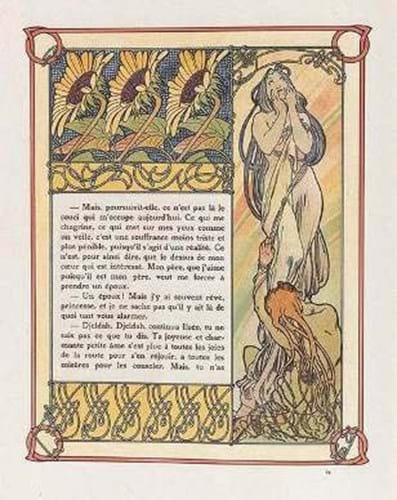
Robert de Flers’ ‘Ilsée, Princesse de Tripoli’ with coloured litho illustration by Alphonse Mucha – $10,000 (£7635) at Swann Galleries.
Shown right is a page from Robert de Flers’ Ilsée, Princesse de Tripoli with text framed by 132 coloured litho illustration by Alphonse Mucha. The work has been described as Mucha’s “most complete statement in the Art Nouveau style… [and] one of the best examples of total book design”.
One of 252 copies printed in Paris in 1897, and still bright and fresh in the original pictorial wrappers and folder, it was sold for $10,000 (£7635) by Swann Galleries (25/20/12% buyers’ premium) on January 29.
Houdini pitchbook
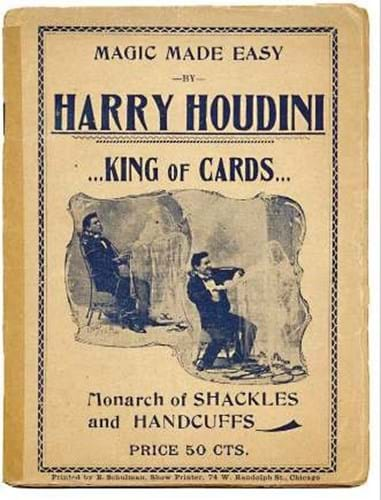
‘Magic Made Easy’ – $8000 (£6105) at Potter & Potter.
The October 20 sale held by US magic specialist Potter & Potter (20% buyer’s premium) included an 1898 50-cent copy of Magic Made Easy… Potter & Potter specialist Gabe Fajuri had been astonished at the find.
“I never thought I’d see, let alone sell a copy of this Houdini pitchbook, published before his rise to fame, when he was truly ‘down and out’ and forced to sell the secrets behind magic tricks to help make ends meet.” This rarity doubled expectations to sell for $8000 (£6105).
CS Lewis' first book
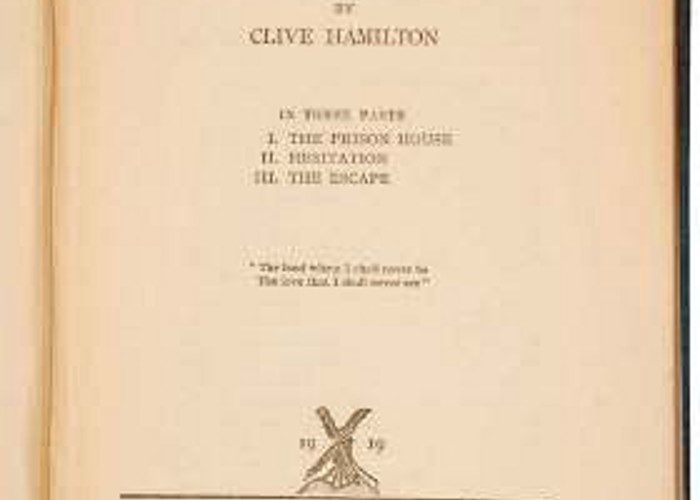
‘Spirits in Bondage’ by CS Lewis – £2800 at Mallams.
Pictured here is the title page of a copy of the very first book by CS Lewis to be printed, Spirits in Bondage of 1919.
A volume of verses published under the name Clive Hamilton, when the writer was just 20 and had only recently returned from military service, it was well reviewed but did not sell well and the publishers are thought to have destroyed the remainders. It was not in the best condition but, as one of only a handful offered at auction in the last 40 years, it sold for £2800 at Mallams (22.5% buyer’s premium) in Oxford on January 28-29.
A copy that made £14,000 at Sotheby’s in 2008 was accompanied by a typed and signed letter in which Lewis identifies Spirits in Bondage as his first work and explains that Hamilton was his mother’s maiden name.
Terra Nova expedition ephemera
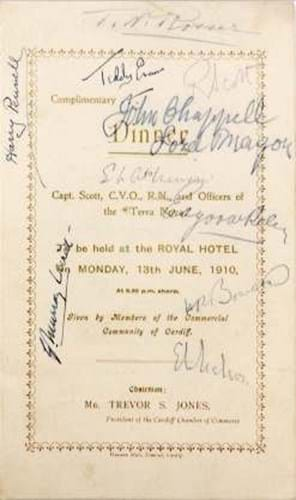
Signed menu from a dinner given for Captain Robert Scott and the officers of the Terra Nova ship at the Royal Hotel, Cardiff, on June 13, 1910 (two days before sailing) – £5100 at Stroud Auction Rooms.
Ephemera relating to Captain Robert Scott’s ill-fated Terra Nova Expedition to the Antarctic in 1910 was eagerly contested at Stroud Auction Rooms on January 9. An online buyer in the Czech Republic bought many of the lots that were consigned for sale by direct descendants of Captain Thomas Newland Rosser (1857- 1935), the dockmaster when the Terra Nova set sail from Bute Docks, Cardiff, in June 1910.
Rosser met Scott on several occasions before the expedition’s departure and a signed menu from a dinner given for Scott and the officers of the ship at the Royal Hotel, Cardiff, on June 13, 1910 (two days before sailing) sold for £5100 plus 18% buyer’s premium
Scott and a number of companions died during the expedition but a dinner to honour the survivors on Terra Nova’s return to Cardiff took place at the Royal Hotel almost exactly three years later on June 16, 1913. A signed menu from this occasion made £3500 (estimate £150-300) at the auction.
‘Turn-up’ text
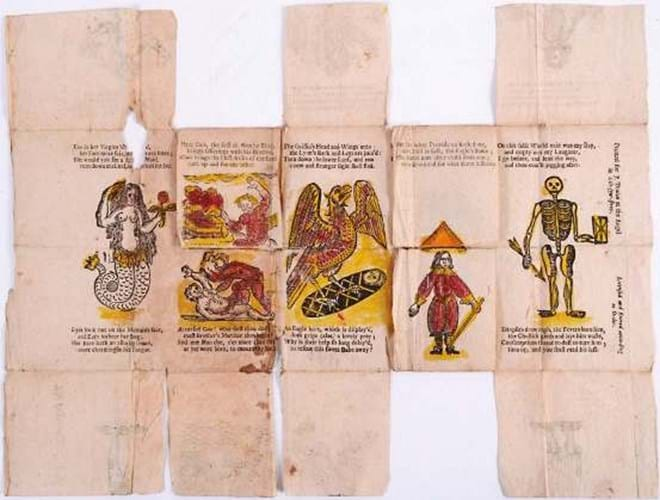
‘Turn-up’ religious text, printed in London c.1688-89 – £7600 by Lawrences of Crewkerne.
This ‘turn-up’ religious text, The Beginning, Progress and End of Man, printed in London c.1688-89, was sold to a buyer on thesaleroom.com for £7600 by Lawrences of Crewkerne (25% buyer’s premium) on March 8.
It presents, on one now defective sheet, five sets of cut flaps that open to reveal a second series of images.
One of these ‘turn-ups’ is in the British Library dated to 1660 and another, similar example is in the Bodleian Library, but no other coloured examples are known.
Tyndale’s New Testament
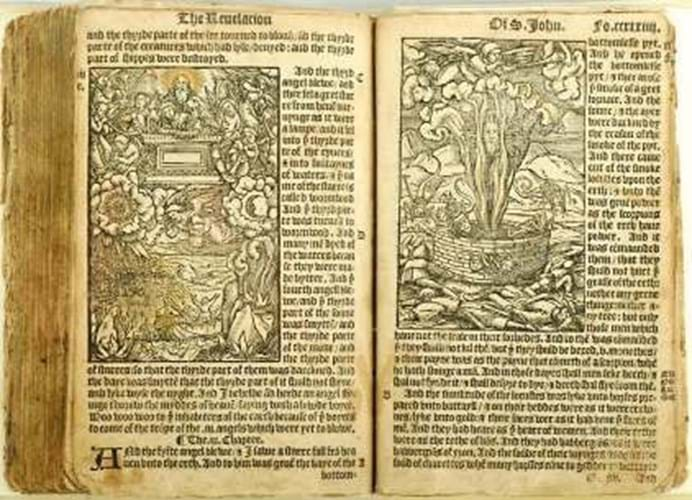
1536 copy of the ‘mole’ edition of Tyndale’s ‘Newe Testament’ – £30,000 at Chiswick Auctions.
A 1536 copy of what is known as the ‘mole’ edition of Tyndale’s Newe Testament made £30,000 at Chiswick Auctions (25% buyer’s premium) in London on November 28.
This copy, Tyndale’s enormously influential, vernacular translation, based mainly on Erasmus’ edition of the Greek text, was first published in 1525 in Worms. It was condemned by Cardinal Wolsey and the clerical establishment and a great many copies of Tyndale’s translation were destroyed. This ‘Once agyane Corrected’ version, printed in Antwerp a decade later, takes it title from the mole (or perhaps hedgehog) depicted on a stone on which St Paul’s foot is resting in one of the many woodcut illustrations.
Offered in a rebacked 17th century binding of mottled calf, it lacked 48 leaves in all, was somewhat stained and browned and bore a few small library stamps.
Burned at the stake as a heretic, Tyndale is said to have cried out “Lord! Open the King of England’s Eyes”, and within two years Henry VIII had indeed authorised a translation that became the Great Bible of 1539-40.
James Joyce's glasses

Pair of spectacles owned by James Joyce – €17,000 (£15,130) at Fonsie Mealy.
The December 4 sale held in Dublin by Fonsie Mealy (20% buyer’s premium) included a pair of spectacles owned by James Joyce that came from the collection of his friend, Thomas Pugh.
Believed to have been those used by James Joyce while writing Ulysses and familiar from many photographs, including his passport, they were given to Pugh during one of his visits to Joyce in Paris. They sold at €17,000 (£15,130).
Judge's copy of Lady Chatterley’s Lover
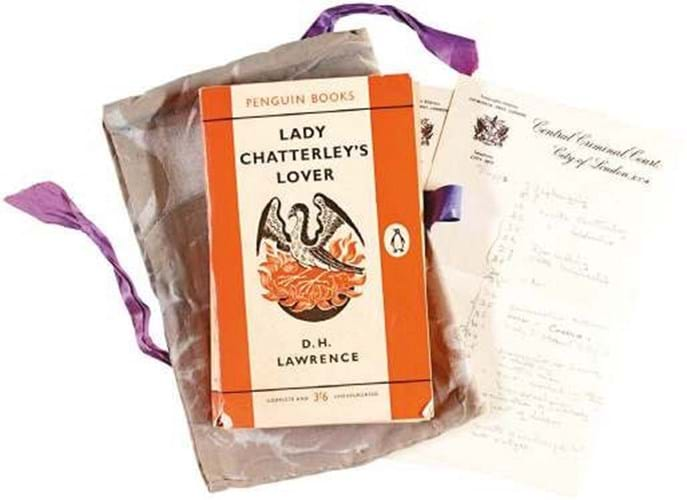
Penguin printing of DH Lawrence’s ‘Lady Chatterley’s Lover’ used by the presiding judge in the famous 1960 obscenity trial – £45,000 at Sotheby’s.
This Penguin printing of DH Lawrence’s Lady Chatterley’s Lover is the very copy used by Sir Laurence Byrne, the presiding judge in the famous 1960 obscenity trial.
It was Sir Laurence who famously asked of the jury: “Would you approve of your young sons, young daughters – because girls can read as well as boys – reading this book? Is it a book that you would have lying around in your own house? Is it a book that you would even wish your wife or your servants to read?”
The defence called 35 eminent literary and academic figures to give their opinions on Lawrence’s artistry, intentions, and treatment of sex and the jury took just three hours to return a not guilty verdict. When last seen at auction, in 1993, this famous copy – complete with markings around the sexually explicit passages – sold for £3800. Offered for sale on November 1 at Sotheby’s (25/20/12.9% buyer’s premium) from the English residence of Christopher Cone and the late Stanley J Seeger (d.2011), it took £45,000.
Edgar Allan Poe’s Tales
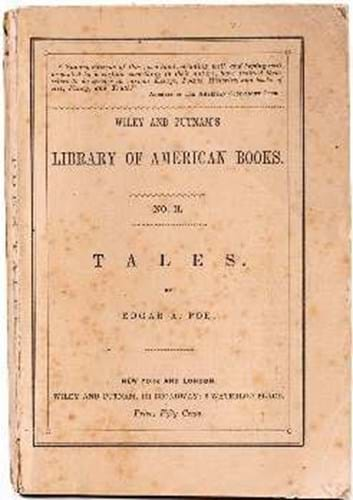
First issue copy of Edgar Allan Poe’s ‘Tales’ – $260,000 (£203,125) at Skinner.
The Fall of the House of Usher, The Murders in the Rue Morgue, The Mystery of the Marie Roget and The Purloined Letter are among now famous works that are to be found in this newly discovered first issue copy of Edgar Allan Poe’s Tales.
Published at 50 cents in 1845 as the second title in Wiley & Putnam’s ‘Library of American Books’, and still in pretty reasonable condition in its paper wrappers, this rare copy was found earlier this year in the attic of a New England home, where it appears to have lain untouched over a great many years. On November 18, in a Boston sale held by Skinner (23/20/10% buyer’s premium) it sold at $260,000 (£203,125) – equalling a record set seven years ago at Sotheby’s New York for the ex- Bradley Martin copy.
Kelmscott Press drawing
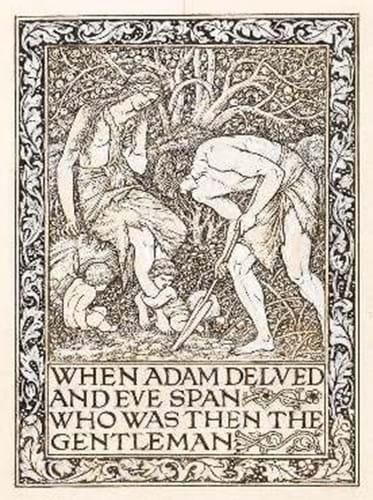
This Kelmscott Press preparatory drawing for the frontispiece to ‘A Dream of John Bull’ – £8500 at Forum Auctions.
This Kelmscott Press preparatory drawing for the frontispiece to A Dream of John Bull sold at Forum Auctions (25/20/12% buyer’s premium) on January 30 for £8500.
The ink over pencil design, last seen at Sotheby’s in 1983, bears a pencil note at the foot stating that it came from the collections of Charles Fairfax Murray, who became Edward Burne-Jones’ first studio assistant in 1867 and later worked for Morris as an artist and copyist.
Murray’s task was to prepare illustrations for engraving. He would draw over a pale photograph image of original drawings, first in silver-point or pencil and then in ink with a fine brush, before they were transferred photographically to the woodblock for engraving.
Stock Exchange tome

‘Confusion de Confusiones’ by Joseph Penso de la Vega, a 1688 first edition – $300,000 (£238,095) at Sotheby’s.
Confusion de Confusiones written by Joseph Penso de la Vega in 1688 is the first book to describe the workings of a stock exchange. In it Vega, a Sephardic Jew whose family had settled in the Netherlands, provides a detailed explanation of the ‘puts, calls, pools, and manipulations’ of the Amsterdam stock exchange, where, it is said, he lost and won back his fortune five times.
This Spanish language account remained little known until 1892, when German economist Richard Ehrenberg published an essay in the Jahrbücher für Nationalökonomie und Statistik. Translations into German and Dutch followed in 1919 and 1939, and in 1957 an abridged English translation brought the text even wider recognition.
Very few copies of the 1688 first edition appear to have survived and the only other example seen at auction was sold by Sotheby’s New York back in 1987, for £15,000.
This copy, offered as part of a Sotheby’s (25/20/13.9% buyer’s premium) online sale that closed on December 17, was sold by the Jewish Theological Seminary to benefit its Rare Book Acquisition Fund. The winning bid for this ‘legendarily rare first edition’ was a high-estimate $300,000 (£238,095).
Beano No 1
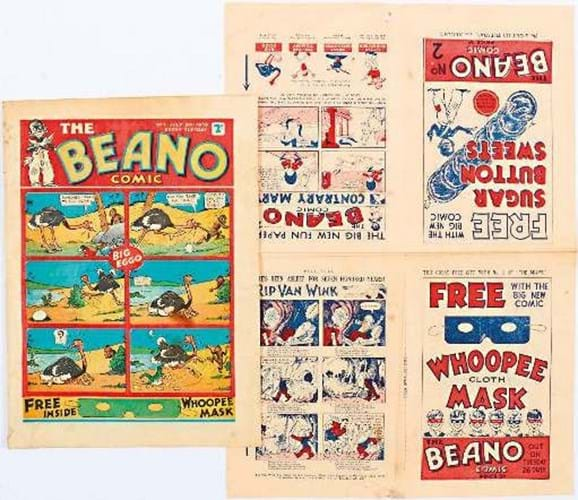
Beano comic No 1 from July 1938 – £8700 at Comic Book Auctions.
This Beano comic No 1 from July 1938 came for sale at Comic Book Auctions on March 3 from an ephemera collector of more than 40 years who had bought it in the early 1980s. It was missing the Whoopee Mask issued as a free gift (that seldom survives) and was slightly marred by staple rust, but did include the four-page promotional flyer that was issued with No 1 and No 2 and slipped inside copies of Hotspur, Adventure, Rover, Skipper and Wizard.
The successful online bidder at £8700 (plus 19% buyer’s premium) was based in Singapore.
George Catlin archive
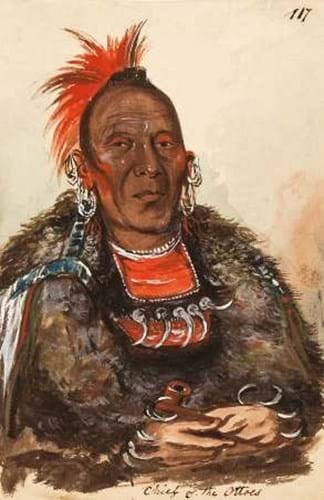
A watercolour by George Catlin of Wah-ro-néesah, The Surrounder – £89,000 at Forum Auctions.
Previously unpublished sketches and letters by the American artist and traveller George Catlin (1796-1872) attracted multiple bidders at Forum Auctions (30/24/14.4% buyers premium) on March 28.
The cache of 13 lots came for sale by descent from the family of the artist’s ‘dear friend’ Captain William Henry Shippard. Against a low estimate of around £23,000, they sold for over £150,000.
Catlin is considered the first white man to depict the people of north America in their native territory. During the 1830s, in the wake of Andrew Jackson’s controversial Indian Removal Act, he undertook five journeys west, his finished works exhibited in Catlin’s Indian Gallery that toured the US and European capitals. It was Catlin’s hope that the 607 pictures and artefacts would be acquired by the US government: however in 1852 he was forced to sell to the industrialist Joseph Harrison.
The financial hardship that led to this painful decision is documented in four pages of a letter written by Catlin to Shippard. “Since the sudden and unexpected seizure of my collection, I have been using every effort I could to save it and to enable me to pay all the debts I owe… and as the only means of doing that, with the enormous costs now accrued my offers are before the American and the French Governments”. This desperate plea for assistance sold at £4000.
However, in financial terms, the undoubted highlights of this album were a series of 10 x 6in (25 x 15cm) watercolour portraits produced by Catlin in situ in the early 1830s. A watercolour, Wah-ro-néesah, The Surrounder, Chief of the Tribe with an estimate of £3000-5000 sold at £89,000 to an agent acting for a North American collector. Catlin, who produced a fully worked oil of the sitter for his gallery, probably painted Wah-ro-néesah in 1832, while at Fort Leavenworth in modern day Kansas, describing his subject as “quite an old man; his shirt made of the skin of a grizzly bear, with the claws on”.


